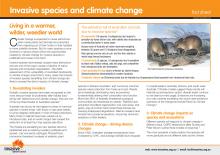Cane toad strategy for Western Australia 2014 to 2019

BRB
Available Online
The Government of Western Australia, Department of Parks and Wildlife
Cane toads introduced to Queensland in 1935, are major environmental pests in Western Australia, having arrived here in February 2009. The Liberal National Government released a 10-year Cane Toad Strategy for Western Australia in 2009. Over the first five years of the strategy, much has been achieved and the government has invested more than $7.8 million in on ground activities and research to help control the spread of can toads. With a range of stakeholders, including community groups, universities, the Australian Government, local shires, Indigenous groups and others, the State of Government has implemented many new can toad management programs including a field-based cane toad surveillance and response team, strengthened quarantine measures, a free-call hotline to report cane toad sightings and cane toad drop off points. Major biological survey work has provided benchmark information on important island wildlife populations that need priority protection from cane toad. Biological controls are also being researched for the survival of native wildlife species in the short and medium terms and management of cane toads in the longer term. Educating the community has prevented new populations from establishing in Perth and elsewhere. Detector dog specially trained to sniff out cane toads is a proactive measure to stem the spread of this noxious pest. This is a review and update on the original 10 year strategy to review and update the strategy to reflect progress in implementation, the current status of cane toads in WA and results of ongoing research, and to refocus its aims and objectives. Cost effective activities and an integrated approach with other initiatives across WA, such as the $81.5 million Kimberley Science and Conservation Strategy, are required. The revised Cane Toad Strategy for Western Australia 2014-2019 will ensure the available information is used to inform Was continued management of cane toads.









